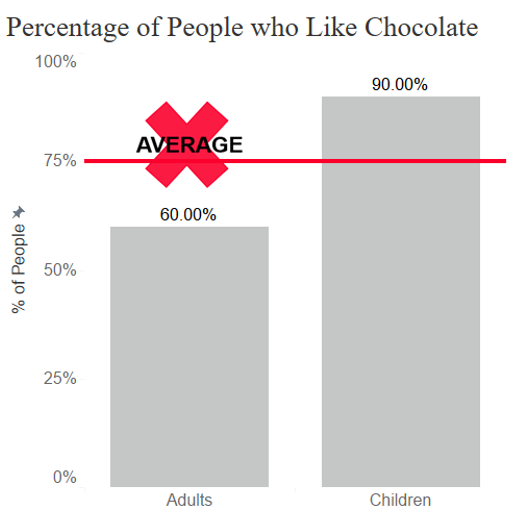This business calculates churn rate using the following formulas:
Customers Serviced = Starting Customers + New Customers
Churn Rate = Customers Lost / Customers Serviced
This works well for calculating the churn rate of the period. We generally are calculating this on a monthly basis, but would like the team to be held to a standard across a 6-month period (to smooth out variance of a particular month). If we apply the above formulas to 6-months worth of data we will get a larger % than the monthly period, which is accurate, but not helpful. We need to understand what the average monthly churn rate was during the 6-month period so we can set that as the target and report on how the team is doing every month using the monthly number.
Example:
Month 1
Starting Customers (1) = 1126
New Customers (1) = 85
Customers Lost (1) = 18
Customers Serviced (1) = 1211
Churn Rate (1) = 1.49%
Month 2
Starting Customers (2) = 1193
New Customers (2) = 25
Customers Lost (2) = 11
Customers Serviced (2) = 1218
Churn Rate (2) = 0.90%
Month 3
Starting Customers (3) = 1207
New Customers (3) = 41
Customers Lost (3) = 20
Customers Serviced (3) = 1248
Churn Rate (3) = 1.60%
Month 4
Starting Customers (4) = 1228
New Customers (4) = 30
Customers Lost (4) = 13
Customers Serviced (4) = 1258
Churn Rate (4) = 1.03%
Month 5
Starting Customers (5) = 1245
New Customers (5) = 36
Customers Lost (5) = 24
Customers Serviced (5) = 1281
Churn Rate (5) = 1.87%
Month 6
Starting Customers (6) = 1257
New Customers (6) = 46
Customers Lost (6) = 23
Customers Serviced (6) = 1303
Churn Rate (6) = 1.77%
Semi-Annual
Starting Customers = 1126
New Customers = 263
Customers Lost = 109
Customers Serviced = 1389
Churn Rate = 7.85%
How can the 7.85% value be expressed in a monthly way so when the team is given their performance for the month at the end of the month they know how they're trending towards the target? Is a simple average correct, or is that going to cause an issue? Is that not considering the severity one way or another of each month? We're not necessairly seeking the average monthly rate, but more interested in the performance over the 6-months expressed in a monthly size.
Appreciate any help and let me know if there is anything I can clarify!
Customers Serviced = Starting Customers + New Customers
Churn Rate = Customers Lost / Customers Serviced
This works well for calculating the churn rate of the period. We generally are calculating this on a monthly basis, but would like the team to be held to a standard across a 6-month period (to smooth out variance of a particular month). If we apply the above formulas to 6-months worth of data we will get a larger % than the monthly period, which is accurate, but not helpful. We need to understand what the average monthly churn rate was during the 6-month period so we can set that as the target and report on how the team is doing every month using the monthly number.
Example:
Month 1
Starting Customers (1) = 1126
New Customers (1) = 85
Customers Lost (1) = 18
Customers Serviced (1) = 1211
Churn Rate (1) = 1.49%
Month 2
Starting Customers (2) = 1193
New Customers (2) = 25
Customers Lost (2) = 11
Customers Serviced (2) = 1218
Churn Rate (2) = 0.90%
Month 3
Starting Customers (3) = 1207
New Customers (3) = 41
Customers Lost (3) = 20
Customers Serviced (3) = 1248
Churn Rate (3) = 1.60%
Month 4
Starting Customers (4) = 1228
New Customers (4) = 30
Customers Lost (4) = 13
Customers Serviced (4) = 1258
Churn Rate (4) = 1.03%
Month 5
Starting Customers (5) = 1245
New Customers (5) = 36
Customers Lost (5) = 24
Customers Serviced (5) = 1281
Churn Rate (5) = 1.87%
Month 6
Starting Customers (6) = 1257
New Customers (6) = 46
Customers Lost (6) = 23
Customers Serviced (6) = 1303
Churn Rate (6) = 1.77%
Semi-Annual
Starting Customers = 1126
New Customers = 263
Customers Lost = 109
Customers Serviced = 1389
Churn Rate = 7.85%
How can the 7.85% value be expressed in a monthly way so when the team is given their performance for the month at the end of the month they know how they're trending towards the target? Is a simple average correct, or is that going to cause an issue? Is that not considering the severity one way or another of each month? We're not necessairly seeking the average monthly rate, but more interested in the performance over the 6-months expressed in a monthly size.
Appreciate any help and let me know if there is anything I can clarify!

